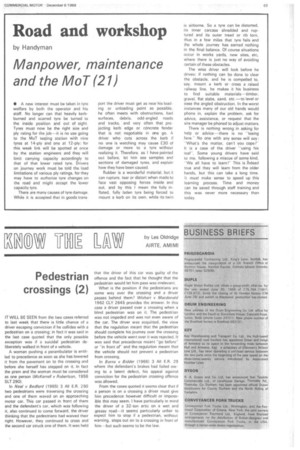Road and workshop
Page 71

If you've noticed an error in this article please click here to report it so we can fix it.
by Handyman
Manpower, maintenance and the MoT (21)
• A new interest must be taken in tyre welfare by both the operator and his staff. No longer can that heavily kerbburned and scarred tyre be turned to the inside position and out of sight. Tyres must now be the right size and ply rating for the job—it is no use going to the MoT testing station with nine tyres at 14-ply and one at 12-ply: for this weak link will be spotted at once by the station engineers and they will limit carrying capacity accordingly to that of that lower rated tyre. Drivers on journey work must be told the load limitations of various ply ratings, for they may have to authorize tyre changes on the road and might accept the lower capacity tyre.
There are many causes of tyre damage. While it is accepted that in goods trans port the driver must get as near his loading or unloading point as possible. he often meets with obstructions, bad surfaces, debris, odd-angled roads and tracks, and very often that projecting kerb edge or concrete fender that is not negotiable in one go. A driver who cuts across the kerb if no one is watching may cause £30 of damage or more to a tyre without realizing it. Therefore, as I have pointed out before, let him see samples and sections of damaged tyres, and explain how they have been caused.
Rubber is a wonderful material, but it can rupture, tear or distort when made to face vast opposing forces inside and out, and by this I mean the fully inflated, fully laden tyre being forced to mount a kerb on its own, while its twin
is airborne. So a tyre can be distorted, its inner carcase shredded and ruptured and its outer tread or rib torn, thus in a few miles that tyre fails and the whole journey has earned .nothing in the final balance. Of course situations occur in works yards, new sites, etc, where there is just no way of avoiding certain of these obstacles.
The wise driver will look before he drives: if nothing can be done to clear the obstacle, and he is compelled to, say, mount a kerb or cross a raised railway line, he makes it his business to find suitable materials—timber, gravel, flat slabs, sand, etc.—to level or ease the angled obstruction. In the worst instances many of our old hands would phone in, explain the problem, ask for advice, assistance, or request that the site manager be phoned to adjust matters.
There is nothing wrong in asking for help or advice—there is no "lasing face." No one with any sense will say: -What's the matter, can't you cope?" It is a case of the driver "using his loaf-. Some young drivers have said to me, following a miscue of some kind, "'We all have to learn!" This is indeed true and they will learn from the older hands, but this can take a long time. It must make sense to speed up this learning process. Time and money can be saved through staff training and this was never more necessary than today.








































































































































































